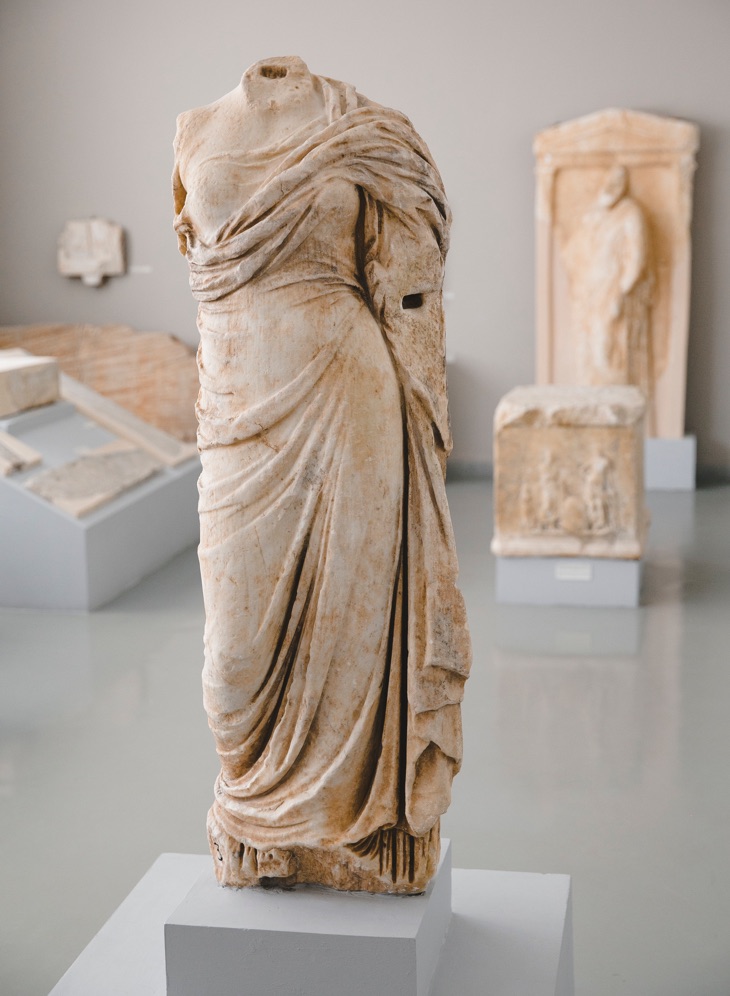HISTORY
Montofoli Estate is a landmark for the region. It’s history – ancient and recent – is well documented and has been established through archaeological findings.
Most of them are displayed in the Archaeological Museum of Karystos and some still lie on the estate.
The buildings on the estate are built during different periods. Traces of the long history are still evident in both architecture and ornaments. The wine cellar is, for instance, housed in what was once the 12th century church of St Marcus, and a stable during the Ottoman occupation. A grand succession of marble stairs – the remains of an ancient road – runs through the terraces of the vineyard.
During the Ottoman occupation, the estate became a favoured retreat of Ömer Bey of Karystos – later Pasha of Evia – and was thereafter known as ‘The Pasha’s Gardens.’
After the liberation in 1833, the estate was acquired by Ioannis Paparrigopoulos, Vice-Consul of Russia and later Chamberlain at the court of King George I and adviser to the Greek State.
In 1877 the estate passed on to Ioannis Konstantinidis, a wealthy merchant from Alexandria, Egypt of Karystian descendence. The cosmopolitan new owner preserved it in perfect condition and strengthened its productive exploitation, particularly famous for its lemons.
In the middle of the 20th century the property was abandoned and fell into ruin. The sensational buildings and terraces became “beautiful ruins”.
In 1986, the family of Pavlos Karakostas bought the estate from Konstantinidis grandchildren. Pavlos named the estate “Montofoli”, inspired by the name of the hill on which it lies. The goal of the new owners was to awaken the “Sleeping Beauty’’: restore the historic buildings and cultivate its land by planting a vineyard and giving new life to the existing citrus trees.

HISTORY
The Estate has been a landmark for the region throughout time. The recent history of the Estate is well documented, and its earlier history has been established through archaeological findings.

Some of them are displayed in the Archaeological Museum of Karystos and more still lie on the estate.
The buildings on the estate were built during different periods. Traces of this long history are still evident in both their architecture and decoration. One part of the wine cellar, for instance, is housed in what was once the church of Saint Marcus, while the other was previously a stable constructed during the Ottoman occupation. A grand succession of marble stairs – the remains of an ancient road – runs through the terraces of the vineyard.
During the Ottoman occupation, the estate became a favoured retreat of Ömer Bey of Karystos – later Pasha of Evia – and was thereafter known as ‘The Pasha’s Gardens.’
After the liberation in 1833, the estate was purchased by Ioannis Paparrigopoulos, Vice-Consul of Russia and later Chamberlain at the court of King George I and adviser to the Greek State.
In 1877 Ioannis Konstantinidis, a wealthy merchant from Alexandria, Egypt, acquired the estate. The cosmopolitan new owner preserved it in perfect condition and strengthened its productive exploitation, particularly lemons.
In the 20th century -in the 50’s – the property was abandoned and fell into ruin. The sensational buildings and terraces became “beautiful ruins”.
In 1986, the estate was acquired by the family of Pavlos Karakostas. The estate was then named “Montofoli” after the hill on which it lies. The goal of the new owners was to awaken the “Sleeping Beauty’’: restore the historic buildings and cultivate its land by planting a vineyard.
Some of them are displayed in the Archaeological Museum of Karystos and more still lie on the estate.
The buildings on the estate were built during different periods. Traces of this long history are still evident in both their architecture and decoration. One part of the wine cellar, for instance, is housed in what was once the church of Saint Marcus, while the other was previously a stable constructed during the Ottoman occupation. A grand succession of marble stairs – the remains of an ancient road – runs through the terraces of the vineyard.
During the Ottoman occupation, the estate became a favoured retreat of Ömer Bey of Karystos – later Pasha of Evia – and was thereafter known as ‘The Pasha’s Gardens.’
After the liberation in 1833, the estate was purchased by Ioannis Paparrigopoulos, Vice-Consul of Russia and later Chamberlain at the court of King George I and adviser to the Greek State.
In 1877 Ioannis Konstantinidis, a wealthy merchant from Alexandria, Egypt, acquired the estate. The cosmopolitan new owner preserved it in perfect condition and strengthened its productive exploitation, particularly lemons.
In the 20th century -in the 50’s – the property was abandoned and fell into ruin. The sensational buildings and terraces became “beautiful ruins”.
In 1986, the estate was acquired by the family of Pavlos Karakostas. The estate was then named “Montofoli” after the hill on which it lies. The goal of the new owners was to awaken the “Sleeping Beauty’’: restore the historic buildings and cultivate its land by planting a vineyard.



